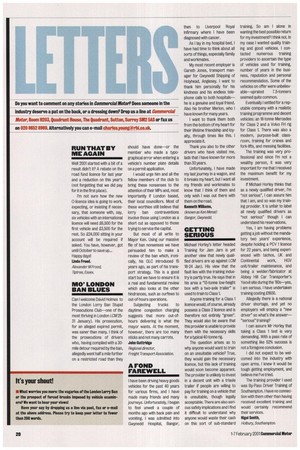GETTING SERIOUS
Page 22

If you've noticed an error in this article please click here to report it so we can fix it.
Michael Horley's letter headed Training for Jam Jars is yet another view that newly qualified drivers are up against (CM 18-24 Jan). His view that the fault lies with the training industry is partly true. He says that in his area a "13-tonne low-height box with a two-axle trailer" is used to train to Class 1.
Anyone training for a Class 1 licence would, of course, already possess a Class 2 licence and is therefore not entirely "green". They would also be aware that this provider is unable to provide them with the necessary skills for a typical 40-tonne rig.
The question arises as to why anyone would want to train on an unsuitable vehicle? True, they would gain the necessary licence, but this lack of training would soon become apparent. The provider is unlikely to invest in a decent unit with a triaxle trailer if people are willing to pay for training on a vehicle that is unsuitable, though legally acceptable. There are also serious safety implications and I find it difficult to understand why anyone would waste their cash on this sort of sub-standard training. So am I alone in wanting the best possible return for my investment? I think not. In my case I wanted quality training and good vehicles. I contacted numerous training providers to ascertain the type of vehicles used for training, number of years in the business, reputation and personal recommendation. Some of the vehicles on offer were unbeliev able—uprated 7.5-tonners seemed quite common.
Eventually I settled for a reputable company with a realistic training programme and decent vehicles: an 18-tonne Mercedes for Class 2 and a Volvo FH rig for Class 1. There was also a modern, purpose-built classroom, training for cranes and fork-lifts, and messing facilities.
The training was very professional and since I'm not a wealthy person, it was very important for me that I received the maximum benefit for my investment.
If Michael Horley thinks that as a newly qualified driver, I'm "not serious", I can assure him that I am, and so was my training provider. It is unfair to label all newly qualified drivers as not serious" though I can understand his reservations.
Yes, I am having problems getting a job without the mandatory two years' experience, despite holding a PCV 1 licence for 22 years, and being experienced with tachos, UK and Continental work, HGV unit/trailer maintenance, and being a welder/fabricator at Abbey Hill Car Transporter's Yeovil site during the '80s—yes. I am serious. I have undertaken training costing £1600.
Allegedly there is a national driver shortage, and yet no employers will employ a "new driver" so what's the answer— "serious" training?
I can assure Mr Horley that taking a Class 1 test is very demanding. With a pass rate of something like 52% success is not a foregone conclusion.
I did not expect to be welcomed into the industry with open arms. I knew it would be tough getting employment, and believe me I've tried.
The training provider I used was By-Pass Driver Training of Southampton. I have no connection with them other than having received excellent training and would certainly recommend their services.
eigei Smith, Holbury, Southampton.
































































































